Sponsored by
We are currently seeking a sponsor for this website
as it follows the progress of the excavations on the battlefield, with contributions from established historians and well known experts, as the team attempt to match the historical evidence and family history to the archaeology on the ground.
If you enjoy this website
please consider making a donation towards the costs of the project.

|
Changing the Geography Saturday, August 8th, 2009
|
|
|
|
|
The Plugstreet Project team was on site between Friday 31st July and Thursday August 6th. Unfortunately, rather intermittent internet connections at the Peace Village in Messines meant that we were unable to blog while actually out in the field. However the next few entries will give you a flavour of what happened, as well as a few thoughts and reflections on the site, the Project and some of the wider issues attendant on Great War conflict archaeology.
_
This summer the main team was based, once again, in the field by Ultimo Crater, where we opened a number of trenches, some more confusing than others. Meanwhile we were ably supported by the Finds and Conservation team back up at the Peace Village. Meanwhile Team Colonel was primarily out on Hill 63 at Le Rossignol surveying features around the Chateau de la Hutte, getting bitten by horseflies and trying to avoid the field with the bull in!
_
Trench 1 produced the most spectacular results, architecturally speaking, as Steve’s team uncovered a very nice right-angled fire trench dug into the lip of the mine crater and overlooking no-mans-land and the German positions.
_
Trench 2 was a speculative test pit and produced nothing.
_
Trench 3 crossed two sections of German trench and also revealed the roof of a demolished German concrete shelter. This area also included a rather nice midden deposit that included the star find (of which more later)… as well as bottles, tins and a number of stick grenades.
_
Trench 4 was intended to find the in-situ remains of the German concrete shelter, which it did. Unfortunately we got the front face and the breastwork cast up around it, rather then the rear, which was the target, so that we could see the relationship between trench and bunker.
_
Both trenches 3 & 4 were in the trees and suffered from very hard ground, as it hasn’t rained as much in Belgium as in UK, so the trees have taken up much of the groundwater! All credit to both teams. However, they did have shade, unlike trenches 1 & 5 – until I put team 4 into the crater!
_
Trench 5 saw the redeployed team from T2 opening an area on top of German communication trench. The maps and air photos were unclear about whether it had continued in use following the capture of the area in June 1917. They actually produced remains of at least 2 German trenches, as well as communications wire, post holes and trench boards. Both trenches appeared to have been filled by upcast soil from the mine, as there was no evidence of post-war clearance debris in them. So the date of the fill is between 03.30 and 03.35 on 7th June 1917 (so for any Prehistorians reading that’s a really secure date, without need for Bayesian analysis)
_
Trench 6 saw the T4 team go down beside the water-filled Ultimo Crater where they uncovered the remains of what is probably a collapsed shelter dug into the face of the crater following its capture by the Anzacs. Such utilisation of craters was common, with shelters in the crater and defensive positions on the lip.
_
Photographs will follow later, once I can upload a few.
|
|
|
|
|
|
Filed under: A Dig Diary by
admin
1 Comment »
|
|
Digging Up Plugstreet Tuesday, July 28th, 2009
|
|
|
|
|
We have just been told that “Digging Up Plugstreet” by Richard Osgood and Martin Brown will be going to press this afternoon.
_
This account of our research to date is published by Haynes and is available through Amazon, as well as from all good bookshops.
_
Amazon.co.uk
_
Haynes
_
Rest assured that Martin and Richard will be rearranging the displays in bookshops to give themselves more prominence. I am assured it’s the perfect Christmas gift for the Great War obsessive in your household.
|
|
|
|
|
|
Filed under: A Dig Diary by
admin
Add a Comment »
|
|
Standing To! Wednesday, July 15th, 2009
|
|
|
|
|
It’s that time of year again.
_
We will be on site from Friday 31 to Thursday 6th August at St Yvon.
_
The main team will be looking for further evidence of the Australian fortification of the mine crater and of ground held following the Messines attack. In addition we hope to investigate the entrance to a German concrete shelter to see something of the architecture and stratigraphy of the access to it from the trench.
_
While the main thrust of fieldwork will concentrate on the 33 Bn objectives from 7th June 1917, The Colonel will be leading a recce party to look at Hill 63 and carry out geophysical survey that we hope will inform work in coming years.
_
As ever we will be joined by our Belgian friends, including members of the Comines-Warneton Historical Society.
_
Not all the regulars will be with us in Belgium, we’ll be missing James, Chass, Lesley, Birger and Jon, but we do say “Congratulations!” to Sylvia who isn’t coming out on the paltry excuse that she is getting married!
_
We hope to be continuing with the blog while we are away. Watch this space.
|
|
|
|
|
|
Filed under: A Dig Diary by
admin
Add a Comment »
|
|
Updates Monday, June 22nd, 2009
|
|
|
|
|
The dates for the August season at Ploegsteert have been announced and the likely team members alerted. It’s nice to be looking forward to another week in the field.
_
Meanwhile our friends from GWAG and our own Rod have been busy looking for the traces of WW2 anti-invasion defences and WW1 anti-aircraft defences at Shooters Hill, near Woolwich in London. You can see what they’ve been up to here:
_
http://diggingdadsarmy.blogspot.com
_
And finally…
Richard and Martin hosted a Bristol University Masters group for a week of excavation on part of the Bustard practice trench system. While one area opened gave inconclusive results, apart from as a rubbish dump, the other revealed a beautifully dug, deep trench cut into the chalk.
|
|
|
|
|
|
Filed under: A Dig Diary by
admin
Add a Comment »
|
|
Lost in Flanders Wednesday, April 22nd, 2009
|
|
|
|
|
Anzac Day is almost upon us – April 25th. Some my recall the filming of the first season of excavation back in 2007 – well this will form part of a documentary, ‘Lost in Flanders’, that is being aired in Australia tomorrow. A link to a site with a promo of the programme is here:
www.screenaustralia.gov.au/showcases/lostinflanders
_
Along with Jo, Becks, Martin (and perhaps others?!) the film will include two members of the team from 2007 – Mat and Michael.
_
Left: Mat, right: Michael
_
|
|
|
|
|
|
Filed under: A Dig Diary by
admin
Add a Comment »
|
|
The Value of Archaeology Saturday, March 28th, 2009
|
|
|
|
|
Some time to reflect later..
_
An amazing amount was packed into the No-Man’s-Land rescue work at St Yvon. Survey using GPR (radar) and other geophysical techniques were excellent in locating some of the mine shafts in the region – excellent news for the overall project research.
_
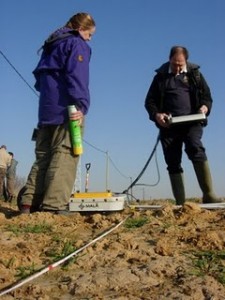
Radar in Operation with Peter and Becs
_
The top of the bunker we found was viewed in full by the farmer who thinks he will only need to move a small part of it to prevent damage to his plough and there should be no risk of damage to the British trenches. The true value of archaeological research was thus shown.
_
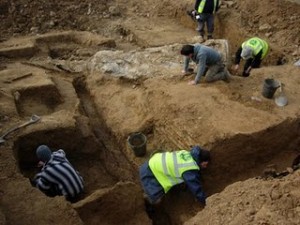
Working on the trenches, bunker and trench boards
_
As mentioned earlier – many finds. From butterscotch tins, pipe stems and mirrors to medicine bottles and an Australian shoulder title and (?) Fusilier shoulder title.
_
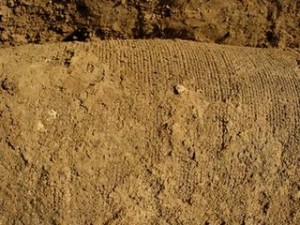
A sandbag filled with concrete and still showing the original weft
_
We always work with the highest standard of bomb cover, essential both in dealing with live ammunition and also in identifying some of the other elements of spent ordnance we uncover. Cheers to Rod and Gontrand once again!
_

Justin and Gontrand at work
_
|
|
|
|
|
|
Filed under: A Dig Diary by
admin
Add a Comment »
|
|
Beneath Flanders (or Wallonian) fields Tuesday, March 24th, 2009
|
|
|
|
|
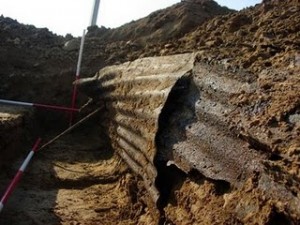
The Traverse in the British trench, St Yvon 2009
_
The team is now back from an enormously successful piece of rescue archaeology at St Yvon. For three days we recorded the remnants of a bunker that lay on the front of the British line. In association with this concrete structure was the multi-phase British fire trench, initially with brick footings and then with trench boards, corrugated iron revetting and A-frames. _
_
A concrete-filled sandbag also survived. As one would expect, the trench had hundreds of spent .303 rounds, along with rum jar and more personal items such as a pipe, mirror and some printed material; perhaps part of a racy magazine story at first glance! Much more to follow…
_
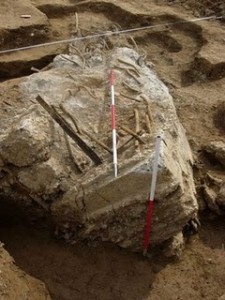
Remnants of the Bunker
_
Thanks to the Comines-Warneton history Society, Mnr Delrue, Messines Peace Village and (of course) Claude and Nelly at L’Auberge in Ploegsteert. the weather was fine, the beer good and the team excellent. Hurrah!
|
|
|
|
|
|
Filed under: A Dig Diary by
admin
1 Comment »
|
|
Ground Penetrating Radar Wednesday, March 18th, 2009
|
|
|
|
|
The Project team want to say a very big thanks to Geomatrix and to their owner Chris Leech.
_
The company (Geomatrix Earth Science Ltd) offers one of the largest hire pools of near surface geophysical instrumentation in Europe. They are exclusive sales representatives for many of the leading geophysical instrument and software manufacturers. Their instruments are world renowned for their emphasis on providing high data quality and instrument reliability in the most arduous of field conditions (which now includes former battlefields).
_
Geomatrix are loaning us GPR (Ground Penetrating Radar) equipment to help us survey the British line, and to have a look at Jon’s German position, that we started to excavate last year.
_
We welcome Geomatrix as the first Corporate Sponsor of the Plugstreet Project and welcome their contribution to our on-going research into both the battlefield itself and into the use of geophysics on this sort of site.
_
We hope to be able to post results of the survey soon, so you can see their amazing kit in action.
www.geomatrix.co.uk
|
|
|
|
|
|
Filed under: A Dig Diary by
admin
Add a Comment »
|
|
Back Into The Line Sunday, March 15th, 2009
|
|
|
|
|
On Friday a small party of us will be going out to Belgium.
_
Last year during ploughing the tenant discovered the remains of a British concrete bunker. Unsurprisingly he wasn’t happy about a bent plough and a load of rubble in the potato field so plans to remove it. Fortunately the landowner told us that this will happen and has given us the opportunity to undertake rescue recording of the bunker and do a limited amount of excavation around it in the British Line.
_
Previously we have never had opportunity to look at the British trenches so this is both exciting and very useful for our research into the development of the battlefield.
_
As usual we will be staying with our friends at the Peace Village in Messines and enjoying the excellent food of Claude at The Auberge at Plugstreet – www.auberge-ploegsteert.be
_
We hope to be updating the blog during our stay.
|
|
|
|
|
|
Filed under: A Dig Diary by
admin
1 Comment »
|
|
The Day Thou Gavest Saturday, February 28th, 2009
|
|
|
|
|
Well we survived the conference.
_
Thank you to all the wonderful speakers for their excellent contributions and for sticking to their allotted timeslots. Also a big thank you to tha audience for a stimulating set of questions and discussions points,as well as for being generally nice people who wanted to talk and even buy us beer!
_
It was good to see a few of the Plugstreet regulars in the audience,as well as our friend Eric,who will be joining us: Welcome Back from “Over There” mate!
_
Meanwhile we’re planning a short foray to record a concrete shelter on the British line before the potato crop goes in. More breaking news soon!
|
|
|
|
|
|
Filed under: A Dig Diary, Conferences & Lectures by
admin
Add a Comment »
|
|
|
|
|
|